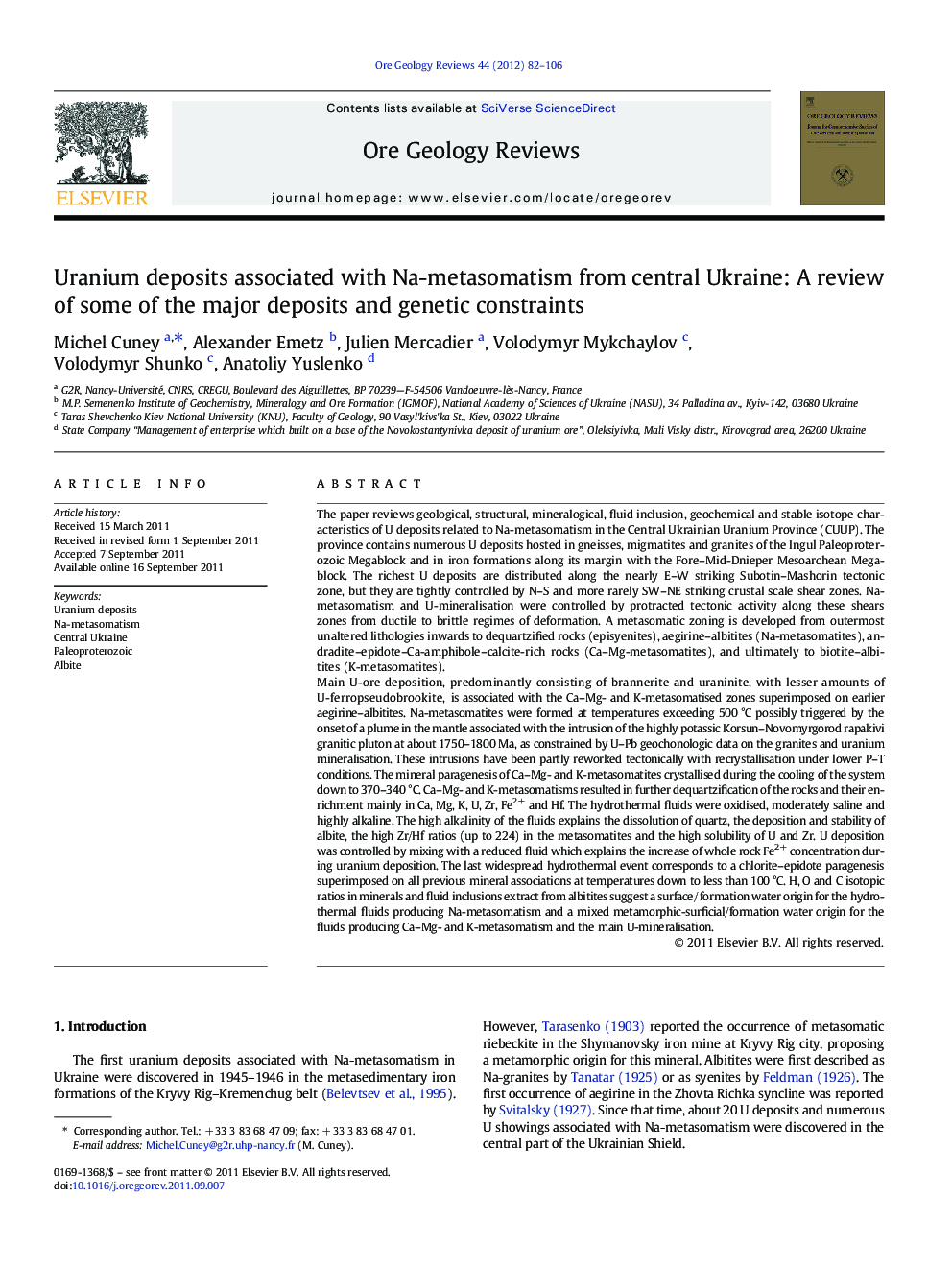| کد مقاله | کد نشریه | سال انتشار | مقاله انگلیسی | نسخه تمام متن |
|---|---|---|---|---|
| 4697666 | 1637259 | 2012 | 25 صفحه PDF | دانلود رایگان |

The paper reviews geological, structural, mineralogical, fluid inclusion, geochemical and stable isotope characteristics of U deposits related to Na-metasomatism in the Central Ukrainian Uranium Province (CUUP). The province contains numerous U deposits hosted in gneisses, migmatites and granites of the Ingul Paleoproterozoic Megablock and in iron formations along its margin with the Fore–Mid-Dnieper Mesoarchean Megablock. The richest U deposits are distributed along the nearly E–W striking Subotin–Mashorin tectonic zone, but they are tightly controlled by N–S and more rarely SW–NE striking crustal scale shear zones. Na-metasomatism and U-mineralisation were controlled by protracted tectonic activity along these shears zones from ductile to brittle regimes of deformation. A metasomatic zoning is developed from outermost unaltered lithologies inwards to dequartzified rocks (episyenites), aegirine–albitites (Na-metasomatites), andradite–epidote–Ca-amphibole–calcite-rich rocks (Ca–Mg-metasomatites), and ultimately to biotite–albitites (K-metasomatites).Main U-ore deposition, predominantly consisting of brannerite and uraninite, with lesser amounts of U-ferropseudobrookite, is associated with the Ca–Mg- and K-metasomatised zones superimposed on earlier aegirine–albitites. Na-metasomatites were formed at temperatures exceeding 500 °C possibly triggered by the onset of a plume in the mantle associated with the intrusion of the highly potassic Korsun–Novomyrgorod rapakivi granitic pluton at about 1750–1800 Ma, as constrained by U–Pb geochonologic data on the granites and uranium mineralisation. These intrusions have been partly reworked tectonically with recrystallisation under lower P–T conditions. The mineral paragenesis of Ca–Mg- and K-metasomatites crystallised during the cooling of the system down to 370–340 °C. Ca–Mg- and K-metasomatisms resulted in further dequartzification of the rocks and their enrichment mainly in Ca, Mg, K, U, Zr, Fe2+ and Hf. The hydrothermal fluids were oxidised, moderately saline and highly alkaline. The high alkalinity of the fluids explains the dissolution of quartz, the deposition and stability of albite, the high Zr/Hf ratios (up to 224) in the metasomatites and the high solubility of U and Zr. U deposition was controlled by mixing with a reduced fluid which explains the increase of whole rock Fe2+ concentration during uranium deposition. The last widespread hydrothermal event corresponds to a chlorite–epidote paragenesis superimposed on all previous mineral associations at temperatures down to less than 100 °C. H, O and C isotopic ratios in minerals and fluid inclusions extract from albitites suggest a surface/ formation water origin for the hydrothermal fluids producing Na-metasomatism and a mixed metamorphic-surficial/formation water origin for the fluids producing Ca–Mg- and K-metasomatism and the main U-mineralisation.
Journal: Ore Geology Reviews - Volume 44, February 2012, Pages 82–106